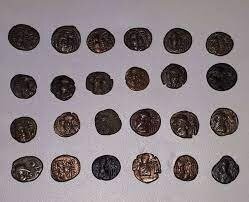Police recover coins dating back to Seleucid, Parthian eras

TEHRAN – On Saturday, the tourism chief of Hamedan province announced the retrieval and seizure of 92 ancient coins dating back to the Seleucid-Parthian periods.
Mohsen Masoum-Alizadeh stated that the recovery was made following credible information and the vigilant pursuit by the heritage protection units in Hamedan regarding the smuggling of historical artifacts by illicit dealers in the Nahavand district.
“The police forces arrested an individual in the act of transporting these relics for sale in a neighboring province, after careful observation and repeated monitoring.”
Highlighting the historical significance of the recovered coins, the official added that the [majority of the] coins are associated with the ancient Elymais state (Hellenic form of the more ancient name, Elam), which was an autonomous state from the 2nd century BC to the early 3rd century CE, frequently a vassal under Parthian control.
Masoum-Alizadeh emphasized the authenticity of the recovered coins, noting that they were predominantly made of bronze and silver, some bearing Greek inscriptions typical of the Seleucid era.
Explaining the historical context, he detailed that Elymais state was a territory linked to the Seleucid-Parthian Empire, comprising present-day provinces such as Khuzestan, Kohgiluyeh-Boyerahmad, Bakhtiari, Lorestan, and Ilam. The Elamite rule dates back to 147 BC in the aforementioned regions.
The recovery stands as a testament to the continuous efforts to preserve and protect the rich historical legacy and cultural heritage of the region, ensuring these invaluable artifacts remain intact for generations to come.
Elymais or Elamais was an autonomous state from the second century BC to the early 3rd century CE, frequently a vassal under Parthian control. The dynasty is believed to have been established by Kamnaskires, known from coins dated 81 BC, and it survived until its extinction by the Sassanid king Ardashir I (180-242 CE).
Khuzestan is home to the three UNESCO World Heritage sites of Susa, Tchogha Zanbil, and Shushtar Historical Hydraulic System, yet it is a region of raw beauty that its visitors could spend weeks exploring. The province is also a cradle for handicrafts and arts whose crafters inherited from their preceding generations.
Lying at the head of the Persian Gulf and bordering Iraq on the west, Khuzestan was settled about 6000 BC by a people with affinities to the Sumerians, who came from the Zagros Mountains region. Urban centers appeared there nearly contemporaneous with the first cities in Mesopotamia in the 4th millennium. Khuzestan, according to Encyclopedia Britannica, came to constitute the heart of the Elamite kingdom, with Susa as its capital.
AFM
Leave a Comment